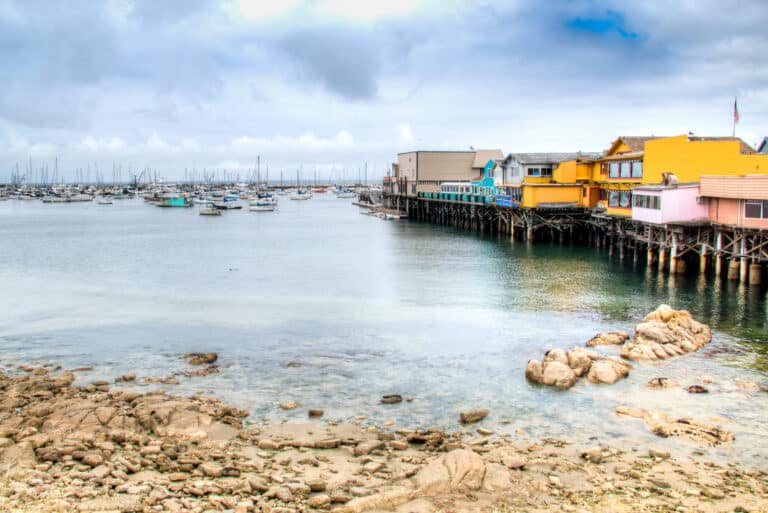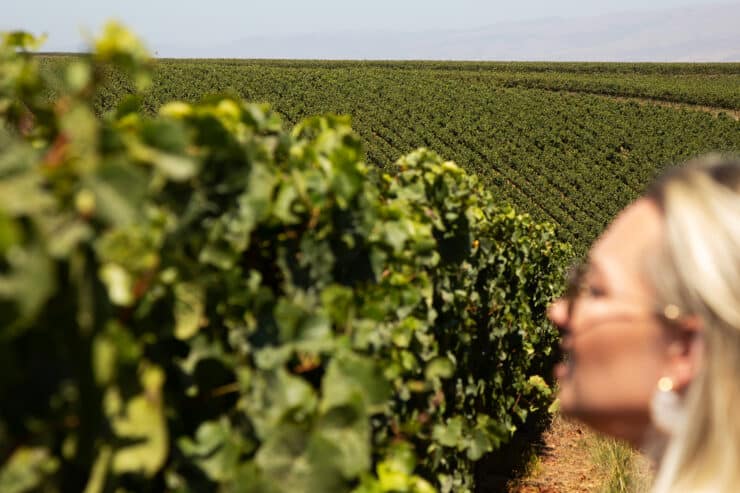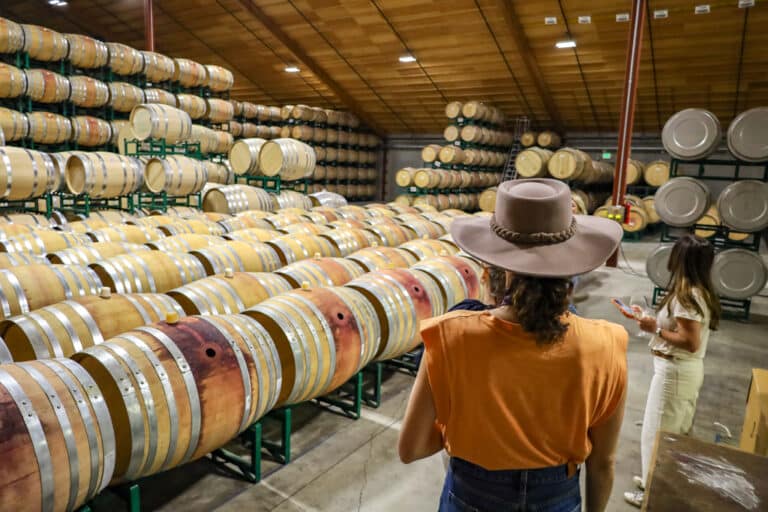Table of Contents
Mention “Monterey, California,” and travelers think of the Monterey Bay Aquarium, Cannery Row, and the stunning Big Sur coast. But Monterey wine tasting should also be top of mind.
Most of our private travel planning clients heading there are on a classic California road trip. And while the coast is stunning, Monterey County has just as much to explore inland with its numerous farmstands and celebrated wineries.
But this wine region flies under the radar for most California travelers. So, on a recent trip with Discover California Wines, we got the lowdown on Monterey wine tasting and all happening in Monterey wine country now.

Why You Should Trust Us
What is Monterey County known for?
A few specific spots (like Fisherman’s Wharf and Pebble Beach) and people (ahem, John Steinbeck) put Monterey County on the map. But it’s also a top spot for agriculture as you can see when you dig into what is grown in Monterey. And, of that agriculture, wine places a large part. Monterey is one of California’s largest wine-producing regions — with more than 46,000 acres planted to wine grapes — so there are a lot of opportunities for a Monterey wine tasting.
History Of Wine In Monterey
We have the Franciscan friars to thank for California’s wine. They planted the first grapes (for sacramental use) in the 1770s near Monterey’s Soledad and San Antonio missions.
The commercial wine industry began in 1919, when Lucius Charles Tamm, planted Chenin Blanc and other grapes at what’s now Chalone Vineyard.
But it was in 1960 that the area garnered serious attention. The University of California at Davis published a report classifying grape-growing districts by climate and Monterey was classified as Region I and II, on par with the world-class regions of Napa, Sonoma, Burgundy, and Bordeaux.
Some early adopters are among the region’s best-known wineries where you can do a Monterey wine tasting including Wente, Mirassou, and J. Lohr.

Central Coast Wines
Having read about the California wine regions you’ll recall that there are essentially five main AVAs – North Coast, Sierra Foothills, Inland Valleys, Central Coast, and Southern — across the state.
The Central Coast AVA covers more than 250 miles from San Francisco to Santa Barbara and includes the state’s oldest and newest wine regions.
A key part of this AVA is Monterey County, which has nine smaller AVAs: Monterey, Santa Lucia Highlands, Arroyo Seco, San Lucas, Hames Valley, Chalone, Carmel Valley, San Antonio Valley, and San Bernabe.
How Many Wineries Are In Monterey Country?
The answer is a lot! Today there are more than 350 vineyards and 82 bonded wineries across Monterey County. So this question is not where to go for Monterey wine tasting but how to go about it.
What Makes Monterey Wine Unique
There are many award-winning wines across the region thanks to talented winemakers as well as to the following factors:
- Climate: Monterey’s most unique feature is the Blue Grand Canyon™. As the largest and deepest canyon on the West Coast, the cold, deep waters of Monterey Bay bring fog and moderate temperatures and give the wine notable structure.
- Soil: More than 80% of the vineyards are planted in eight soil types, which are alluvial, porous, granite, and limestone-rich — perfect for grapevines!
- Sustainability: Commitment to sustainable winemaking is major with 80% of California wine made in a sustainable winery. Local vintners and growers support programs like the Monterey Bay Marine Sanctuary, Seafood Watch, and California Condor restoration.
What Wine Is Monterey Known For?
There are more than 40 wine varietals planted in Monterey county but the two grapes that reign supreme are Pinot Noir and Chardonnay.
The northern part of the region is cooler and better suited for growing Chardonnay, Pinot Noir, and Riesling. Meanwhile, the southern part can get rather hot and is better suited to red blends and Bordeaux varietals like Merlot and Cabernet.
Pinot Noir
The defining characteristic of Monterey Pinot Noir is balance. Compared to wines of other regions, Monterey Pinot Noir is more fruit-forward due to the longer growing season provided by the Blue Grand Canyon.
Chardonnay
Monterey County has more Chardonnay acreage planted than any other California county and it accounts for 40% of total grape acreage. The extended ripening period means the wine grapes maintain acidity and make steely wines with lemon-lime and tropical fruit aromas.

Monterey Wineries To Know
Now that you know a bit about what to look for and where to go, here are a few wineries to visit for a Monterey wine tasting:
Caraccioli Cellars
This family-run winery is a relative newcomer (started in 2006) but has quickly made a name for itself. They are often listed as one of the best Monterey wineries and are credited with producing some of the most elegant sparkling wines in California. Head to Carmel-By-The-Sea or to the winery for a tasting and be sure to try the Brut Cuvée and Brut Rosé which are their prize wines.
Scheid Vineyards
Scheid Family Wines has been producing wine in Monterey for 50 years. Today the company is made up of nine wine brands but Scheid Vineyards is the flagship. The winemakers are dedicated to sustainability practices with 100% drip irrigation and 100% of their vineyard power coming from wind turbines. While Pinot Noir and Chardonnay are the stars of Monterey, their other top varietals are Sauvignon Blanc, Cabernet Sauvignon, Merlot, and Petite Sirah.
Talbott Vineyards
The Santa Lucia Highlands is one of Monterey’s premier winegrowing regions and Talbott was one of the first wineries to establish themselves there. In nearly 40 years, they have honed the craft of creating distinct cool-climate Chardonnay and Pinot Noir from their renowned Sleepy Hollow Vineyard. Head to their tasting room in Carmel-By-The-Sea for a taste of these legendary wines.

Where To Go For Monterey Wine Tasting
Across Monterey County there are more than 65 tasting rooms – here is a list of all the tasting rooms in Monterey Wine Country. It’s helpful to know that the Monterey wine tasting rooms are grouped in four primary areas across Monterey County, namely: Carmel Valley Village, Carmel-By-The-Sea, Monterey, and River Road.
Carmel Valley Village
Set a few miles inland from the famed California Highway 1 is the Carmel Valley Village appellation. It’s tucked in the Santa Lucia range and is where you’ll find around 25 tasting rooms as well as chic restaurants, boutiques, and galleries.
Start off your Monterey wine tasting at a classic spot like Bernardus Vineyards or Georis Winery. Or get a broader view of the area and try different producers at once at Village Wine & Tap Room or The Wine House.
Carmel-By-The-Sea
Top of most Monterey Peninsula visitors’ bucket lists is a stop in the quaint town of Carmel-by-the Sea. But wine lovers take note: there are a variety of tasting rooms along Ocean Avenue. If you want to DIY, consider the self-guided Wine Walk-by-the-Sea.
Be sure to visit some of the tasting rooms of the most celebrated local wineries such as Caraccioli Cellars, Folktale Winery, Hahn Family, Scheid Vineyards, and Talbott.
And don’t sleep on The Cheese Shop. This small gourmet market and wine shop have more than 200 cheeses, and a lot of unique wines, and they do wine tastings at the back of the shop.
Monterey
Right in the middle of Monterey’s Cannery Row, you can do a Monterey wine tasting — a few classic options are A Taste Of Monterey and The Wine Experience.
River Road Wine Trail
Nestled in the heart of the Salinas Valley among the Santa Lucia Highlands is River Road. About 15 wineries along a 20-mile route make up the Monterey Wine Trail where you’ll find some of the top boutique wineries on the Central Coast of California.
Tips For Monterey Wine Tasting
Here are a few tips to make the most of your Monterey wine tasting:
Visit One Area
Monterey wine country is big, so plan to visit just one area in one day. Otherwise, you’ll do more driving than wine tasting!
Mix It Up
Thanks to the region’s agricultural diversity, you’ll find farm stands tucked between vineyards. Take advantage of that and mix some non-wine stops such as at the Hacienda Carmel or the downtown Carmel-By-The-Sea farmers market.
Make A Reservation
While many tasting rooms (especially in Carmel-By-The-Sea) are fine to just walk into for a Monterey wine tasting, the best-known wineries (including those listed above) require reservations. We suggest having at least one reservation so your Monterey wine tasting has a bit of structure.
Where To Eat In Monterey
After all that Monterey wine tasting, you’re going to want a delicious meal. Check out our local recommendations for where to eat in Monterey as well as where to eat in Carmel-By-The-Sea.
Travel To Monterey Wine Country
Did you know we’re also a boutique travel agency that specializes in California vacation planning? If you’re looking to plan a wine country or road trip to California, our California trip planner services are here to help you plan your perfect itinerary.
Photo Credit: Opening photo and photo of woman wine tasting by Jayme Burrows; photo of Fisherman’s Wharf by nicolas decorte; all other photos by Alison Needham for California Wine Institute